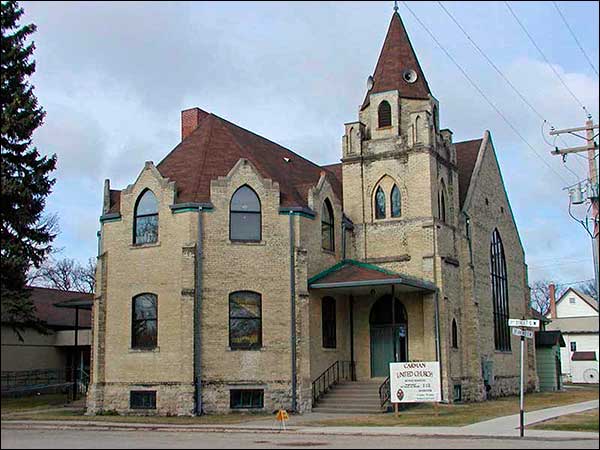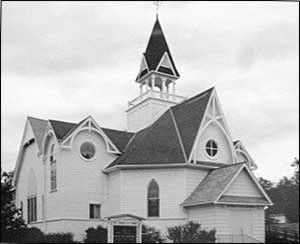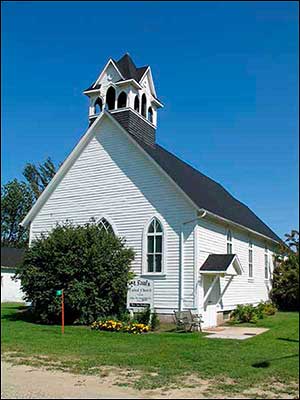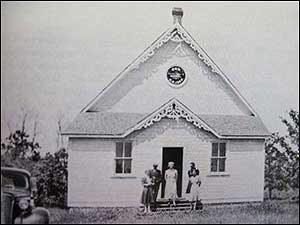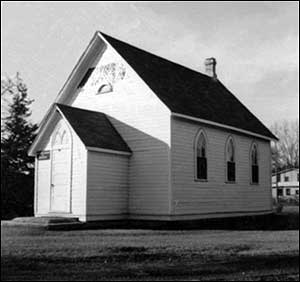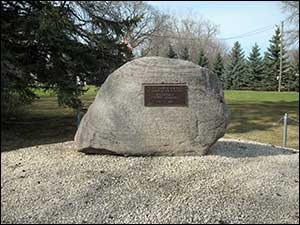Carman
Formed in 1925 by union of Methodists, Presbyterians & Congregationalists, its clergy were among the first Protestant missionaries to the Boyne area.
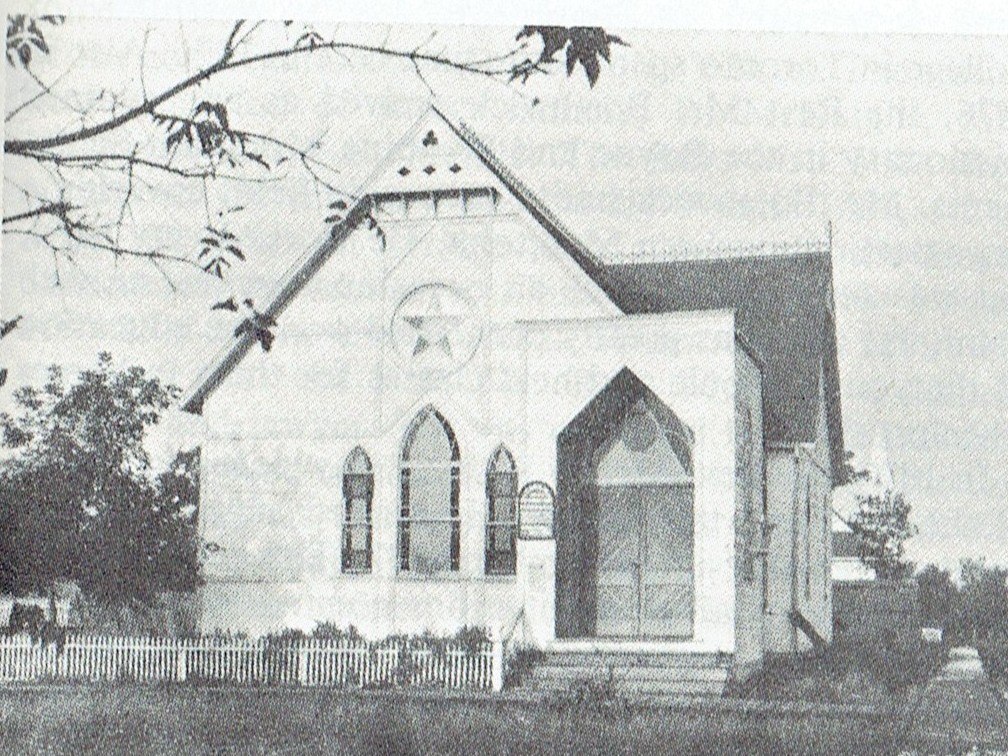
Carman United Church
In 1875, Rev. James Harrison was sent by the Wesleyan Methodist Church as missionary to the Boyne region and the entire area south to Nelsonville. The first Methodist Church in this area was a log cabin at the crossing of the Missouri Trail and Tobacco Creek on NW 17-5-4w about seven miles south of the Boyne on the Missouri Trail. Built in 1878, it was the start of what was known as the Pomeroy Mission. A year later, Methodist Bishop Carman visited the mission; the town that grew up on the Boyne River was later named after him.
Twenty-one years later, the Pomeroy Mission built a second church a half-mile west on the Graham farm. The framed building was erected in 1896 and dedicated on December 13, 1896. The Pomeroy Mission was renamed Grace Church. In 1908 this area became part of the RM of Roland.
Reverend Frank Warne became the first resident minister at the Boyne settlement (1879). He and his wife were provided with a home near the intersection of Villiard Ave and Walnut St. They held church services in the Laidlaw home two blocks south of the river and started the Methodist Episcopal Congregation. In 1881 the congregation bought property in the northeast corner or NE 24-6-4w and a frame church was built. Later, in 1891, a larger frame church was built on the intersection of Fournier Ave and Ash St. In 1902 the Boyne river flood caused extensive damage to the foundation, and on October 2nd, 1905 the church burned to the ground.
The congregation got pledges and built the Albert Carman Memorial Church. The new church was dedicated in January 13, 1907. A short time later it was renamed Wesley Methodist Church. On June 10, 1925 the congregation voted to a church union with St. Andrews Presbyterian Church. After union, Wesley Methodist Church was renamed Wesley United Church. The Church is now called Carman United Church.
The site was designated on March 24, 1988, by the Town of Carman.
St. Andrews Presbyterian Church
The Boyne Settlement along with a large surrounding area were served by missionaries from as early as 1873. Reverend H.J. Borthwick was the first Presbyterian missionary to the area, serving a large area that included the Boyne settlement and extended south to Nelsonville and west to the Pembina Hills.
In 1883, a Presbyterian congregation was formed in the Boyne area and, two years later, a frame church seating 250 people was built in the south end of the settlement that became Carman. As the church grew, a large new building was erected further north on Walnut Street, two blocks from the Methodist Church. The new church seated 450 with spacious facilities, unusual octagonal front and rear areas, stained glass windows and steeple with the bell from the first church.
After union, the church continued holding services for another fifteen years as St. Andrew’s United before moving to the Wesley United Church. It was sold to Church of Christ in 1945. In recent years the building has housed secular amenities such as the Walnut Street Tea Room and Bella Aura Bed and Breakfast.
Graysville St Paul’s United Church
The Graysville congregation formed in 1912 and met in the Orange Lodge Hall until St. Paul’s Presbyterian Church opened early the following year. The frame church was distinguished by a bell tower. In 1919, a manse was built nearby. In 1925, with the union of the Presbyterians and Methodists, the church name was changed to St. Paul’s United Church. The L.O.L. hall, now closed, served as a church hall.
Orr Presbyterian Church
From 1892, services were held at Orr School, Ravenswood School (Almasippi), and Roseisle Presbyterian Church. These mission stations served Presbyterians in the region until 1895 when a resident minister was appointed to preach each Sunday at Orr and alternate Sundays at the other locations. In 1901, a frame church was built near Orr School on SW 26-6-6w. A manse was built nearby. When a church was built at Graysville, Orr Church was moved to SW 10-6-6w to serve a more southerly congregation.
In 1952, the church was sold to the Graysville Mennonite congregation and is still in use; the manse became a private home. The outward appearance of the building was altered by removal of the gingerbread trim to comply with the simpler tastes of the new congregation and by the addition of an entrance-way.
A Presbyterian congregation also met in the Almasippi P.O. area by 1890 with an active Sunday School and Bible Class. Services were held in Ravenswood School.
Homewood
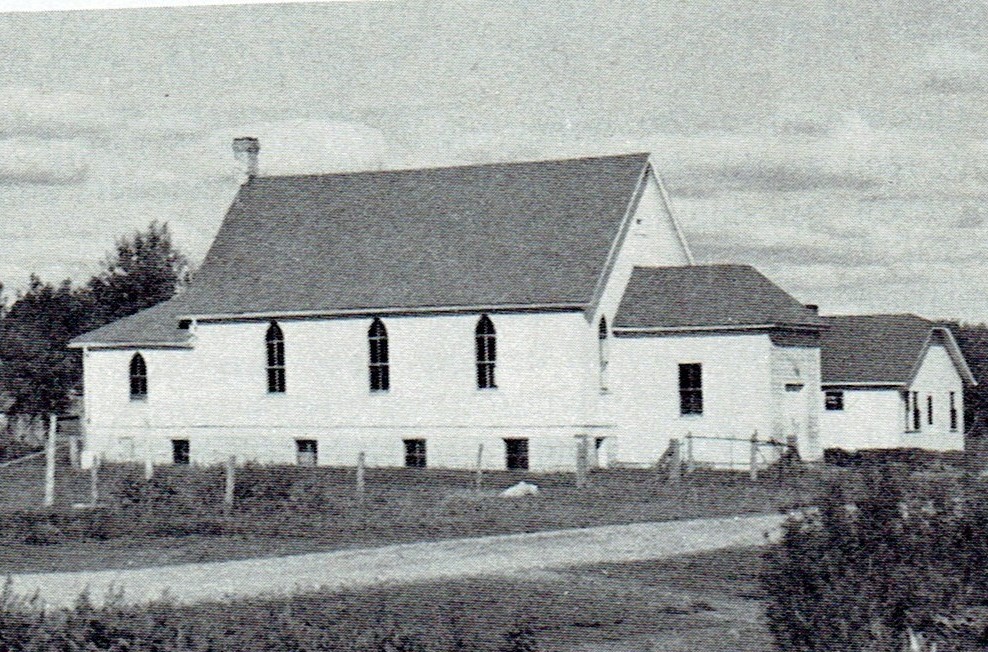
Homewood United Church
In November 1896, Eastland Methodist Church opened on SE 33-6-3W at Bates PO. Prior to this, local settlers met in homes or in Garnett School. In 1903 the church separated from the Carman circuit and took in the Sperling circuit. When the railway by-passed Bates, the church was moved three miles west to Homewood (1912) where it was placed east of the school.
The Church remained Methodist until 1924, when it joined with Century Methodist Church and later with Southland Presbyterian Church to form Homewood United Church, a year before official union.
The congregation had an active Ladies’ Aid. These groups were the volunteer backbone of the United Church and were later known as the Women`s Association (WA) and United Church Women (UCW). Attendance declined after WWII and the church closed in 1968. The building continued service as a community Hall.
Homewood/Sperling
The other early Presbyterian and Methodist Churches in the Homewood/Sperling area were:
Century Methodist Church
In 1900, Century Methodist Church was built on NE 8-6-3w across from Brigdenley School. Two Methodist churches three miles apart proved to be financially challenging. In 1910 the gingerbread trim building was sold to the newly formed Brigdenley Consolidated School District and moved to SW 17-6-3w. The building was demolished in 1969.
Southland Presbyterian Church
In 1899 the Presbyterians of Bates district built a church on NE 17-6-3W near Brigdenley School. Church of England services also were held here. The church closed in 1923. It was sold and moved to SE 9-6-3W.
Egremont Presbyterian Church
In 1898 the congregation met and decided to build their church on SE 6-7-2w in the RM of Morris, however when the cornerstone was laid on May 24th 1899 the site was on SW 36-6-3w. When the railroad came to Sperling, the church was moved in 1903 to the north end of Sperling where it continued to serve until church union. In 1925 the building was torn down and replaced by Sperling United Church.
Roseisle
Roseisle United Church
On May 7th 1891 construction began on a small white church on a sandy knoll half a mile south of the present town-site on land donated by W.D.B. Boyd. Work was completed by June 21st 1891. The railway came through a half mile north of the site and, in 1904, the church was moved to the relocated hamlet of Roseisle. The congregation was initially part of the Ravenswood Mission and shared a minister with Orr Presbyterian Church to the east. The church was assigned a resident minister in 1920, however, by 1929, it became part of the Graysville charge. With church union in 1925, it was given the name of Roseisle United Church.
Roseisle United Church closed its doors in 1971; the building was moved to the Threshermen’s Museum near Morden where it was designated a Municipal Heritage building by Thompson Municipality. A plaque is on the original site.

